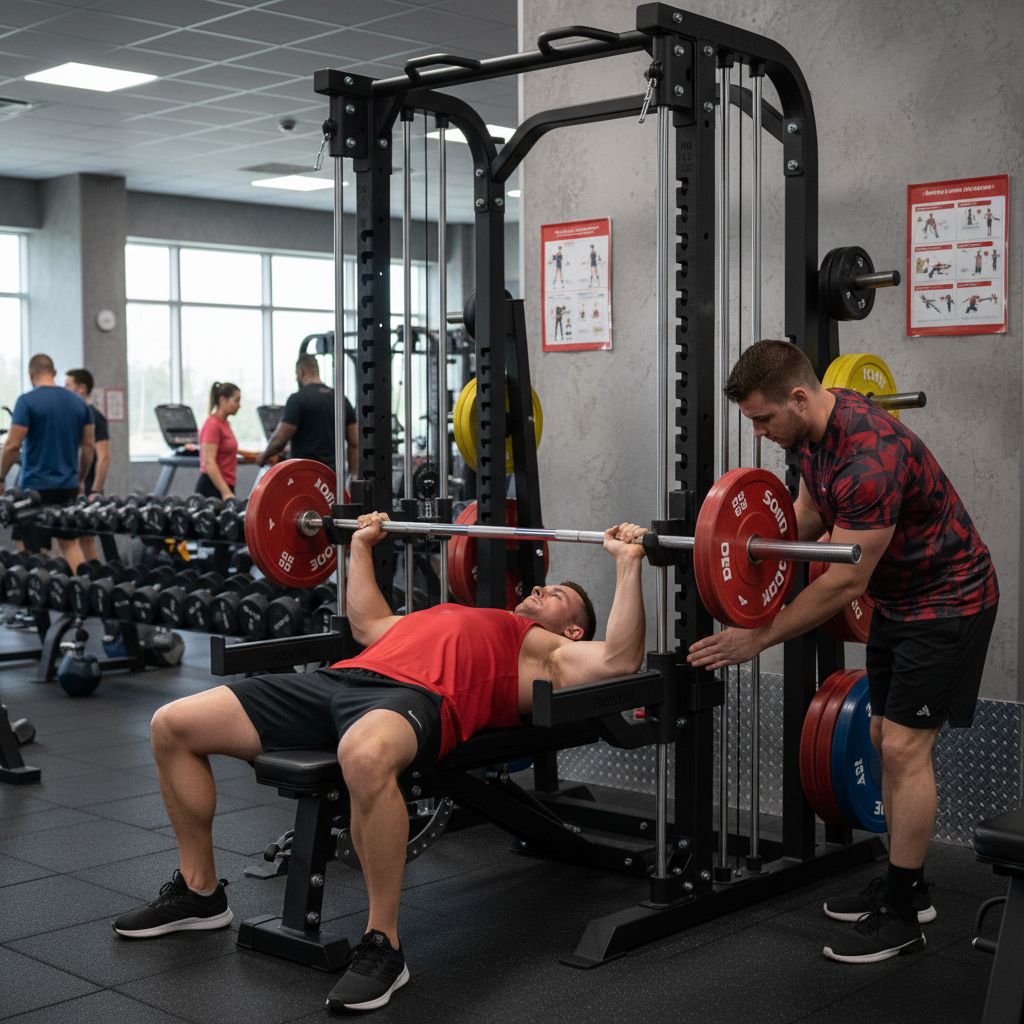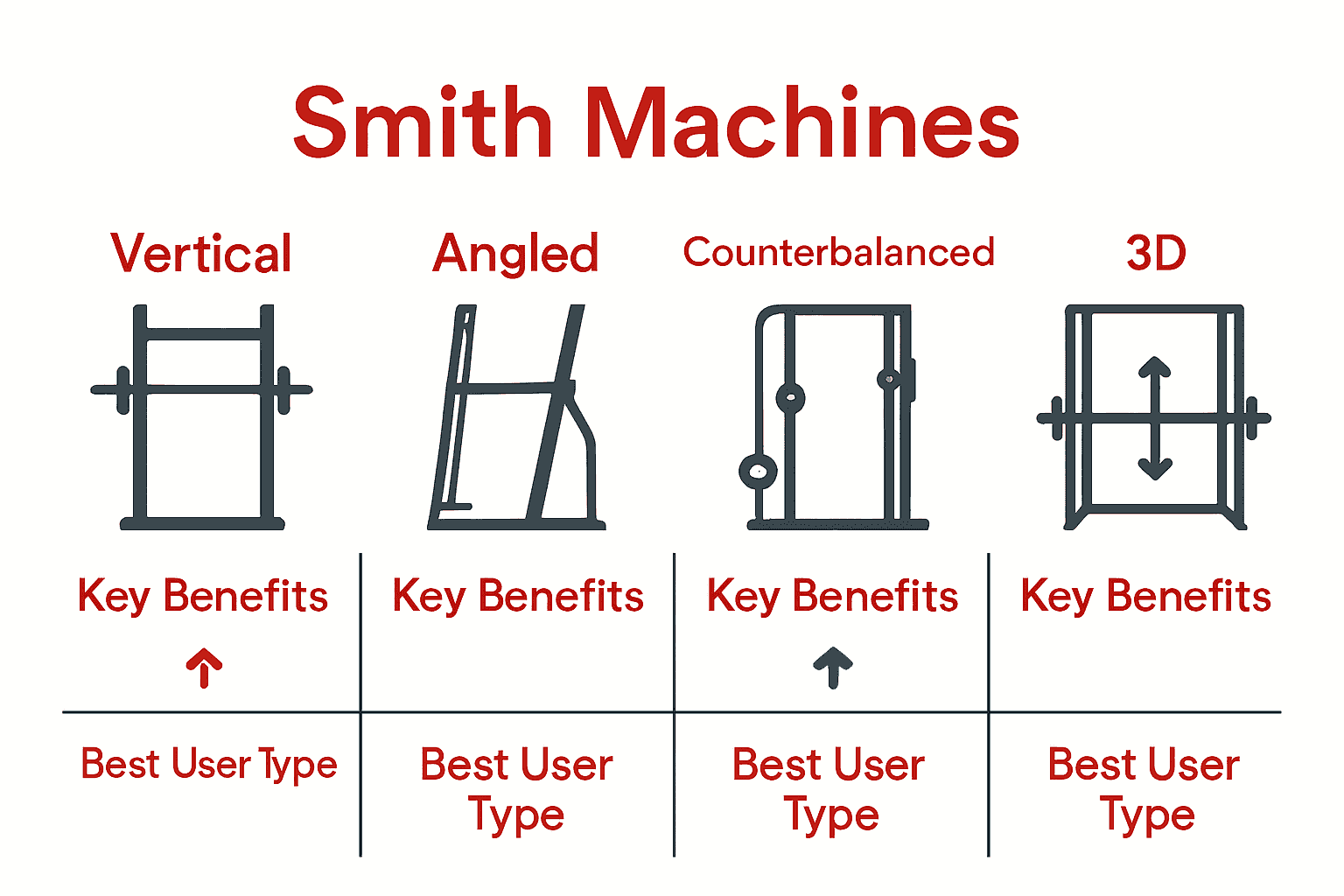Did you know that over 40 percent of gym-goers use a Smith machine for at least one major lift? People are turning to this equipment because it offers reliable safety and precise form, making tough workouts more approachable. Understanding how a Smith machine works gives you the power to train smarter, reduce injury risk, and focus your strength on exactly the muscles you want to build.
Key Takeaways
| Point | Details |
|---|---|
| Smith Machine Definition | A Smith machine is a weight training tool that allows for vertical bar movement, enhancing safety and muscle targeting. |
| Machine Variants | Various types exist, including Vertical, Angled, Counterbalanced, and 3D machines, catering to different needs and fitness levels. |
| Safety Features | Equipped with adjustable stops and self-spotting mechanisms, Smith machines are particularly suitable for beginners and solo lifters. |
| Usage Considerations | Smith machines offer benefits like injury reduction and muscle isolation but can limit stabilizer muscle engagement; proper form is essential. |
Table of Contents
- What Is A Smith Machine? Core Definition
- Types Of Smith Machines And Key Differences
- How Smith Machines Function In Workouts
- Main Features And Safety Mechanisms Explained
- Pros, Cons, And Common Usage Mistakes
- Choosing The Right Smith Machine For Home
What Is a Smith Machine? Core Definition
A Smith machine represents a revolutionary piece of weight training equipment designed to provide enhanced safety and controlled muscle targeting during strength workouts. According to research from fitness equipment experts, this unique machine features a barbell mounted on steel rails that allow only vertical movement, creating a guided lifting experience unlike traditional free weight training.
The primary mechanism of a Smith machine involves a fixed vertical track that constrains the barbell’s movement to a strict up-and-down plane. This design offers several significant advantages for fitness enthusiasts:
- Provides built-in stability for users at different fitness levels
- Eliminates lateral bar movement, reducing injury risks
- Enables isolated muscle group training with precise form
- Allows for heavier lifts without requiring a dedicated spotter

As explained by MajorFitness research, the machine’s counterbalanced system and adjustable safety hooks create a self-spotting mechanism. This means users can rack the bar at any point during an exercise, making it particularly beginner-friendly and ideal for home gym setups. Check out our versatile Smith machine options here to elevate your strength training routine.
Types of Smith Machines and Key Differences
Smith machines are not a one-size-fits-all piece of equipment, with multiple variations designed to suit different training needs and fitness levels. According to research from Vanswefitness, these machines can be categorised into several distinct types, each offering unique benefits for strength training enthusiasts.
Primary Smith Machine Variants
The most common Smith machine types include:
Here’s a comparison of the main Smith machine variants:
| Machine Type | Bar Path | Key Benefits | Suitable For |
|---|---|---|---|
| Vertical Smith Machine | Straight vertical | Compact size Simple operation |
Small spaces Home users |
| Angled Smith Machine | 7-12° tilt | Natural joint movement Comfort |
Intermediate lifters |
| Counterbalanced Smith | Vertical (offset) | Easier control Lighter bar feel |
Beginners Rehabilitation |
| 3D/Multi-Angle Smith | Vertical + forward/back | Greater flexibility Functional movement |
Advanced trainers Functional fitness |
- Vertical Smith Machine: Features a straight, vertical bar path ideal for compact home gyms
- Angled Smith Machine: Incorporates a slight 7-12° tilt to mimic more natural joint movement
- Counterbalanced Smith Machine: Designed with an offset bar weight for easier control, perfect for beginners or rehabilitation training
For those seeking more advanced training options, 3D or Multi-Angle Smith machines provide additional movement flexibility. As explained by Exercise Bliss, these models allow both vertical and forward/backward movement while preventing bar rotation, offering a more functional training experience.
Choosing the Right Machine
Your choice depends on your specific fitness goals, available space, and skill level. Check out our range of versatile Smith machines to find the perfect match for your home or commercial gym setup. Whether you’re a beginner looking for stability or an advanced lifter seeking functional movement, there’s a Smith machine designed to enhance your strength training journey.

How Smith Machines Function in Workouts
Smith machines revolutionise strength training by providing a controlled, guided lifting environment that transforms how users perform complex exercises. According to research from Major Fitness, these machines enable a wide variety of workouts including squats, bench presses, and shoulder exercises by offering unprecedented stability and muscle isolation.
Key Functional Mechanisms
The machine’s core functionality revolves around its unique design features:
- Fixed Vertical Rails: Constrains bar movement to a strict vertical path
- Locking Mechanism: Allows users to twist and lock the bar at multiple positions
- Self-Spotting System: Provides built-in safety for lifting without a partner
- Muscle Targeting: Enables precise isolation of specific muscle groups
However, as noted by Wikipedia research, this controlled environment comes with trade-offs. While the machine reduces the need for balance and helps maintain proper alignment—especially beneficial for beginners—it also diminishes the engagement of stabilizer muscles compared to free weight training.
Practical Application
For those looking to integrate Smith machines into their workout routine, understanding their strengths is crucial. Explore our comprehensive range of multi-gym solutions to find equipment that matches your specific training goals. Whether you’re rehabilitating an injury, perfecting your form, or targeting specific muscle groups, Smith machines offer a unique and controlled approach to strength training.
Main Features and Safety Mechanisms Explained
Smith machines represent a pinnacle of workout safety engineering, incorporating sophisticated design elements that protect users during strength training. According to research from Wikipedia, these machines come equipped with advanced safety mechanisms that fundamentally transform how lifters approach complex exercises.
Core Safety Features
The primary safety mechanisms of Smith machines include:
- Adjustable Safety Stops: Prevent bar descent beyond a predetermined safe point
- Spring-Loaded Hooks: Allow rapid bar racking at any exercise stage
- Counterbalanced Bars: Reduce initial weight resistance for controlled lifting
- Automatic Stoppers: Catch the bar at preset minimum heights
As explained by Major Fitness research, these features make Smith machines especially beneficial for solo lifters and fitness novices. The guided motion tracks reduce injury risks while providing a consistent, controlled lifting experience.
Practical Safety Considerations
Understanding and properly utilizing these safety mechanisms is crucial for effective training. Explore our range of professional Smith machine options to find equipment that matches your specific safety and training requirements. Whether you’re recovering from an injury, building foundational strength, or seeking precise muscle isolation, these advanced safety features ensure a secure and effective workout environment.
Pros, Cons, and Common Usage Mistakes
Smith machines represent a complex training tool with nuanced benefits and potential pitfalls that every fitness enthusiast should understand. According to Wikipedia’s comprehensive research, these machines offer both significant advantages and notable limitations that can dramatically impact workout effectiveness.
Key Pros and Cons
Advantages of Smith machines include:
- Enhanced Safety: Provides reliable self-spotting mechanism
- Muscle Isolation: Allows focused targeting of primary muscle groups
- Beginner Friendly: Offers controlled, guided movement patterns
- Consistent Trajectory: Maintains uniform vertical bar path
However, the machine’s design also presents potential drawbacks:
- Reduced Stabilizer Engagement: Limits natural muscle recruitment
- Unnatural Joint Stress: Fixed path can create biomechanical challenges
- False Confidence: May lead to improper lifting technique
- Limited Functional Movement: Constrains natural motion ranges
Avoiding Common Mistakes
To maximize Smith machine benefits while minimizing risks, users should focus on proper form and understand the machine’s limitations. Explore our professional Smith machine range to find equipment that supports safe, effective training. Remember: Smith machines are tools to complement, not replace, comprehensive strength training strategies.
Choosing the Right Smith Machine for Home
Selecting the perfect Smith machine for your home gym requires careful consideration of space, budget, and specific training goals. According to research from Vanswefitness, home gym enthusiasts have multiple options that can accommodate different workout needs and spatial constraints.
Key Selection Criteria
When evaluating Smith machines for home use, consider these critical factors:
- Space Efficiency: Measure available floor area before purchasing
- Budget Range: Prices vary significantly between basic and advanced models
- Exercise Versatility: Look for machines with multiple attachment options
- Weight Capacity: Ensure the machine supports your current and future strength levels
Recommended Home Gym Options
Depending on your specific requirements, consider these variants:
- Vertical Smith Machine: Compact and budget-friendly, ideal for smaller spaces
- Counterbalanced Model: Offers lighter bar feel, great for beginners
- Multi-Functional Smith Machine: Integrates cable systems for expanded exercise options
As highlighted by Strong Way research, integrated cable systems provide space-efficient, multifunctional solutions that maximize workout potential within limited home gym environments. Explore our comprehensive range of home gym Smith machines to find the perfect match for your fitness journey.
Take the Guesswork Out of Choosing Your Ideal Smith Machine
Now that you have explored the ins and outs of Smith machines in our complete buyer’s guide, you may be wondering how to confidently select the right model for your home gym. Finding gym equipment that matches your goals and ensures both safety and versatility can be overwhelming, especially with so many types and features to compare. Whether your biggest concern is reliable self-spotting, precise muscle targeting, or efficient use of your space, an informed choice is essential for building your strongest self.
Explore Smith Machines and Power Racks for Every Training Level

Do not settle for uncertainty when it comes to your strength training. Browse the best-selling Smith machines and multi-functional equipment at Flex Your Gym and experience a seamless shopping journey. Take action today for a safer and more effective workout environment. Your perfect home gym solution is waiting at flexyourgym.co.uk.
Frequently Asked Questions
What is a Smith machine?
A Smith machine is a specialized piece of weight training equipment that features a barbell mounted on steel rails, allowing for vertical movement to enhance safety and muscle targeting during strength workouts.
What are the benefits of using a Smith machine?
Smith machines provide built-in stability, reduce injury risks by eliminating lateral movement, enable precise muscle targeting, and allow users to lift heavier weights without a dedicated spotter, making them ideal for beginners and home gym setups.
How do I choose the right Smith machine for my fitness goals?
When selecting a Smith machine, consider factors like space efficiency, budget, exercise versatility, and weight capacity. Different types, such as vertical, angled, or counterbalanced, cater to various training needs.
What are the main differences between Smith machine types?
The main types of Smith machines include the vertical Smith machine, which has a straight bar path; the angled Smith machine, which mimics natural joint movement; the counterbalanced Smith machine for easier control; and the 3D or multi-angle Smith machine, which allows for greater exercise flexibility.

